Fleischer/Famous Studios (1941-1943), Warner Home Video (November 4, 2008), 2 discs, 201 mins plus supplements, 1.33:1 original full frame ratio, Dolby Digital Mono, Not Rated, Retail: $34.98
Storyboard:
Popeye joins the Navy and does what he can to help out against America’s enemies, but still has time to fight Bluto, woo Olive (and her look-alikes), and spend time with his nephews.

The Sweatbox Review:
The first volume in this series was overwhelmingly wonderful to this cartoon lover. Once the buzz wore off, and the second volume was looked at, it became truly apparent just how rich this series really was. Far from the one-note Popeye vs. Bluto set-ups that the Popeye cartoons would later devolve into, it was a revelation to find out Popeye was a genuine multifaceted cartoon star. It made one wonder what would separate the third volume from the first two. The answer is apparent on the cover. In this volume, seemingly anticipating America’s upcoming involvement in what was becoming a worldwide conflict, Popeye joins the Navy and begins to face off against the enemies of democracy. A few fistfights with Bluto certainly creep in, but it is Popeye’s involvement with the Navy that practically takes over the series for a time.
This volume also marks the end of two eras. The Fleischer brothers were ousted from their own studio in 1942 after their two attempts at producing features ended up putting the studio too far into the red. Paramount took over the studio, soon renaming it Famous Studios. Though much of the same staff kept working on the Popeyes (including Max Fleischer’s son-in-law Seymour Kneitel, who directed many of the Famous shorts), the cartoons were started on a long period of declining uniqueness and creativity. The other era ending in this set is the period of black and white Popeye cartoons. With the next volume, Popeye will be appearing in color for as long as these sets get produced.
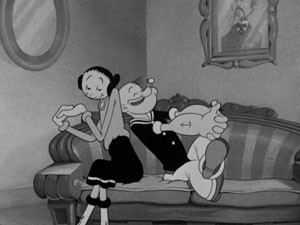
Disc One
This set picks up right where the last one left off, focusing on Popeye’s misbehaving father, Poopdeck Pappy. Problem Pappy sees Popeye once again go after his delinquent dad, who has taken up a job sitting on a flagpole— until a thunderstorm comes by. Next, as Pappy tries to sleep off a little partying, Popeye goes out of his way to make the neighborhood quiet, in Quiet! Pleeze. Pappy then gets a rest after that cartoon, as we don’t see him again for a while. Olive’s Sweepstakes Ticket brings to mind that fun Flintstones episode of decades later, as Popeye tries to help Olive track down a lottery ticket that’s a known winner. Flies Ain’t Human is all about Popeye battling insects, reminiscent of the Donald Duck “bee pictures” (or even the earlier Winsor McCay short How A Mosquito Operates). Popeye Meets Rip Van Winkle, like the William Tell short in the previous set, seems quite out of place. Popeye once again appears to be in a whole different world, complete with forest dwarves. A character from the comic strip makes a rare appearance in Olive’s Boithday Presink, where Popeye tries to buy a fur coat for Olive from Geezil, but ends up going hunting for one himself. Pappy returns in Child Psykolojiky, as he and Popeye argue over how to parent Swee’Pea.
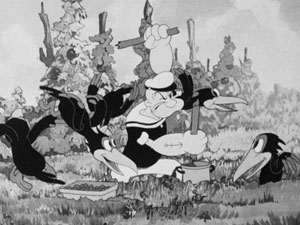
The “opening doors” title sequence goes away now, as the series introduces a new intro largely featuring Popeye’s pipe. Pest Pilot sees Pappy attempting to convince Popeye to let him fly a plane. I’ll Never Crow Again is a fun one that harkens back to the type of shorts we saw in the last set, with Popeye helping Olive out with a domestic problem, in this case a flock of crows. Jack Mercer’s mutterings are in fine form, with lines like, “I’ll ketchup with ‘em” after Popeye is pelted by tomatoes: Also note that at the beginning of this one, Olive is singing It’s A Hap Hap Happy Day from the Fleischer Gulliver’s Travels film.
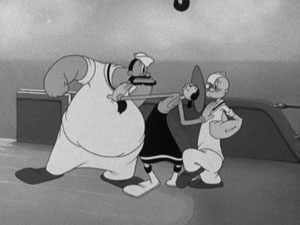
Now, at this point, things really change, as Popeye joins the U.S. Navy in The Mighty Navy. It seems that while Popeye might be a great sailor, he has lots to learn about working on a sophisticated, modern ship. Of course, he comes in very handy when his training ship is attacked by a small fleet showing the flag of “Enemy — Name Your Own.” This is the first cartoon with Popeye switching to an all-white uniform, though he ditches it in favor of his traditional civilian sailor’s outfit in Nix On Hypnotricks, where Popeye has to save Olive from a rogue hypnotist. Popeye dons whites and takes to sea again for the next one; with his ship stopping at a Latin American port, he has a senorita who looks a lot like Olive; naturally, Bluto wants to fight Popeye for her, in Kickin’ The Conga ‘Round.

There is no doubting who occupies the enemy sea ships by the time of Blunder Below, as it has the first appearance in this set of a racist Japanese caricature. Other than that, it’s almost a remake of The Mighty Navy. Popeye is still trying to prove himself in Fleets Of Stren’th, but this time he’s shooting down enemy planes. The Navy cartoons take a break in order to introduce another milestone to the series, Popeye’s nephews. Pip-eye, Pup-eye, Poop-eye And Peep-eye are forced by Popeye to eat their spinach, then get their super-powered revenge. Olive Oyl And Water Don’t Mix sees things head back to the Navy ship, where Olive obviously gets into trouble.

Disc Two
Although Bluto has already appeared as a fellow Navy sailor, in Many Tanks Bluto is part of the Army Tank Corps. Getting back to basics, though, he pounds Popeye (still a sailor) and tries to replace him on a date with Olive. Swee’Pea then returns in Baby Wants A Bottleship , where we see he is almost as much trouble as Olive on a boat.

Uncomfortable caricatures already had appeared by this point, but You’re A Sap, Mr. Jap is bad enough that is has been banned from television by those who have control of such things. This alone makes it notorious, but it is also the first Popeye cartoon to no longer carry the Fleischer name. Instead, the title card simply reads “Paramount Presents Popeye The Sailor.” Alona On The Sarong Seas finds Popeye and Bluto stationed in the South Seas on a tropical island and admiring Princess Alona (Olive again). The Famous Studios title card appears for the first time in A Hull Of A Mess, where Popeye and Bluto compete for a shipbuilding contract. Popeye is again a Navy man, though he fights a Japanese pilot in the air, in Scrap The Japs, which is another cartoon that falls into the “banned” category.
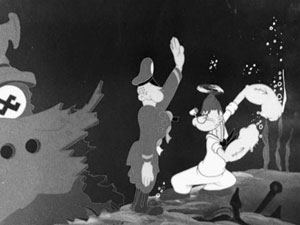
Popeye’s four favorite lads return but don’t want to go to bed, in the rather domestic Me Musical Nephews. In Spinach Fer Britain, Popeye tries to run food to America’s Allies while evading a German ship. Next, Bluto tries to get past Popeye, who is sitting on the Draft Board, in Seein’ Red, White ‘N’ Blue, which has more caricatures that saw it banned from television. Bluto is loafing again in Too Weak To Work, then Popeye gets to see Olive and his nephews during A Jolly Good Furlough. Wartime rationing is addressed in Ration Fer The Duration, with Popeye using a Jack And the Beanstalk story to encourage the boys, before dreaming they are all in the story.
Popeye gets a new adversary in The Hungry Goat, a fellow who wants to eat scrap metal being saved for the War effort, before moving on to Popeye’s ship. Popeye invites a depressed sailor to his Happy Birthdaze party, then gets some time at home but comes up again a feathery pest in Wood-Peckin’. Finally, Popeye makes some home cartoons for the nephews in Cartoons Ain’t Human.

This third volume is clearly most interesting in terms of its historical uniqueness. Many will find Popeye’s decision to join the Navy to be a somewhat remarkable turn of events once you view how this took over the direction of the series. The animation is still quite good through this period, but the same old bounce is already being lost. As the studio became more sophisticated in their techniques, some of the early charm faded away. Popeye is not yet in a rut, but he’s not as novel as he once was.
The issue of racial caricatures is handled with simple warnings on the case, as well as the discs on start-up. Those who are more sensitive may wish to skip some of the cartoons identified in this review, but it’s important that they were included on the set. As Warner Home Video says on the discs, it is better to recognize that this issue existed than to pretend it never did. The cartoons are, after all, a product of their time, and need to be taken as such. And as such, they are fascinating glimpses at the type of propaganda being presented in popular culture. As a parent, I took this as an opportunity to discuss the issues with my child, placing things in context. Regardless of your personal choice, I would certainly not wish the issue to discourage anyone from purchasing a set that has the last of the glorious Fleischer Popeye cartoons.

Is This Thing Loaded?
The number of Audio Commentaries has taken a big dip in this volume, but that is to be expected. Here, the first disc has three, and the second has four. Obviously there is getting to be less to say as the series has gone on for dozens of entries. The first two are actually conversations that Jerry Beck had with the son of director/animator Myron Waldman. Jerry does two more commentaries (one with director Bob Jacques), and John Kricfalusi participates in another.
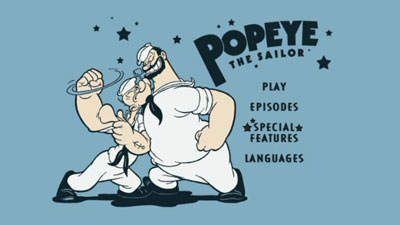
If anyone is still wondering what significance Myron Waldman had, look no further than the first of three Popeye Popumentaries on Disc One. Waldman himself is interviewed, as are his wife and some animation historians. It’s explained here that, although Dave Fleischer was given director credit on all the Fleischer films, many of the direction duties were overseen by the lead animators. The others cover (naturally) Popeye’s joining the Navy, as well as the introduction to Popeye’s nephews. The total runtime on these three featurettes is just under twenty minutes.

Forging The Frame: The Roots Of Animation, 1921-1930 (27:42) looks at the origins of American animation, including the success of cartoons during World War I. Of course, the Fleischer’s Koko The Clown gets plenty of exposure in this featurette, in addition to Felix The Cat, Colonel Heeza Liar, and others. The technical achievements of Max Fleischer are also covered. It’s a little odd to see Warner Home Video go to such lengths in these sets to place the Popeye cartoon series in perspective in relation to the early days of animation. It’s great, but it is removed somewhat from Popeye himself. Still, a good featurette.
Both discs have Bonus Shorts From The Vault. Koko The Clown has three silent shorts on the first disc (The Clown’s Little Brother, The Cartoon Factory, and Koko Needles The Boss). Anyone who has seen these Out Of The Inkwell shorts knows that they are full of invention. The lack of any audio (not even any music) will turn off some, but cartoon historians will certainly enjoy seeing these. The second disc has a 1929 Western Electric short called Finding His Voice (10:46), co-directed by Max Fleischer. This entertaining short looks at the addition of sound to film. It’s actual quite technical and fascinating, in addition to being lots of fun.
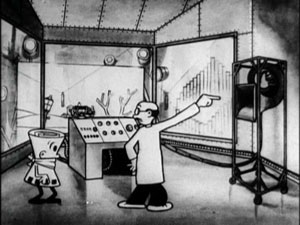
Disc Two also has a few Trailers, including those for a number of Peanuts DVDs, Looney Tunes Golden Collection: Volume 6, and the previous Popeye The Sailor volume.
Case Study:
Same as the previous set, this one comes in a thin digipack with two overlapping discs and full table of contents printed inside. The digipack fits into an embossed slipcase. No inserts this time.

Ink And Paint:
The prints seem to get grainier as this series progresses, suggesting less care taken in the restoration. And, though the cartoons become newer, they are still obviously over sixty years old, so expect to continue to see minor to moderate print damage and assorted physical artifacts, as well as lots of flicker. I won’t criticize too much, though, as this case is better than if Warner had gone with applying DVNR to the proceedings. At least we get to see every ink line even if they keep company with particles of dirt, grain, and a few scratches.

Scratch Tracks:
The audio tracks are decent, and certainly better than they could have been, but the years do take their toll. Range is good, but recording technology of the time did result in less-than-optimal results. A hint of echo is present at times, and fidelity is strained. It’s nothing to ruin the experience, and no worse than what we have been enjoying in the two previous sets. English and French subtitles are provided.
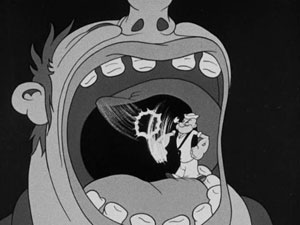
Final Cut:
Okay, you can stop now.
You do need to pick up this set if you were interested enough to get the others, as there is still some mileage in the series at this point. The addition of wartime themes creates new interest, though it can be admitted that these cartoons are not generally as good as the first few dozen Popeye cartoons. With a segue now into the Famous Studios era, the glory days are certainly done. That is not to say that the Famous shorts are without value, but those who wanted to see the best of Popeye on DVD have now done so. Despite some grainy video and a (relative) dwindling of extras, this set remains invaluable to the classic cartoon fan.
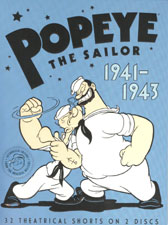 | ||
 |








